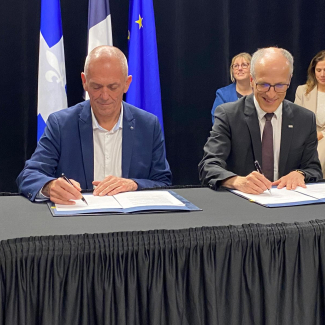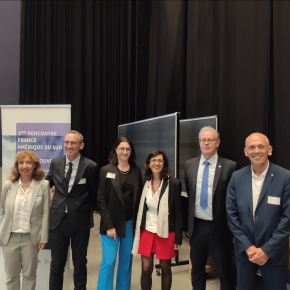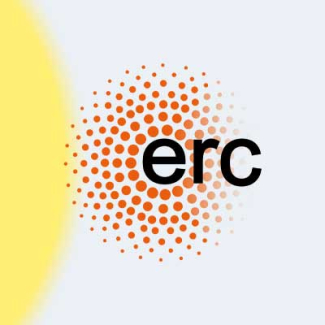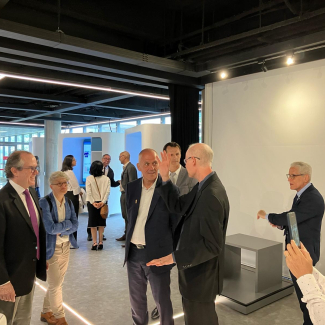
Open Science: an international vision shared with South America
How can we facilitate the advancement of open science on a global scale? The third international open science conference between France and South America revealed numerous connections between CNRS and research organizations in South America. This extended gathering also included Africa and Latin America, offering members of this international network the chance to engage in discussions on open science topics on September 13th and 14th.
"Open science involves reorienting science towards the co-production of knowledge in response to the community's requirements. It is a real change of culture and scientific practices intended to promote the production of knowledge for a fairer society". In his opening speech, Daniel Filmus, Argentina's Minister of Science, Technology and Innovation, reiterated the main challenges of open science which were core subjects of discussion at the third France-South America international open science conference (French link) held on the Pierre-et-Marie-Curie campus in Paris on September 13th and 14th.
UNESCO's recommendation on open science states that "open science respects the diversity of cultures and knowledge systems around the world as foundations for sustainable development". Marcia Barbosa, Secretary of State at Brazil's Ministry of Science, Technology and Innovation (MCTI), took this idea further when she told the conference that "the publication fees charged by some journals are a colonialist attempt to force us to write in English and according to certain standards !"
This meeting of open science stakeholders was the third in two years and reflects the vitality of exchanges between France and Latin America on the subject of open science. It was jointly organised by the French Ministries of Europe and Foreign Affairs and of Higher Education and Research (MESR), the CNRS and the Research Institute for Development (IRD) working in partnership with the MCTI's strategic policies and programmes department. The event underlines France's commitment to building a shared international vision for open science with South America.
Latin America – an open access pioneer
There is also a good reason for this commitment. Many of the speakers at the event referred to the fact that Latin America is a pioneer in this field. Arianna Becerril, a professor at the Autonomous University of Mexico State and executive director of Redalyc1 , the reference open science network in Latin America, Spain and Portugal, took stock of a quarter of a century of public policies in favour of open science. Seventeen years after its launch, Redalyc now hosts 1600 journals and has published 800,000 articles in open access from 750 organisations in 31 countries. Alongside this we should add SciELO2 , Redalyc's Brazilian counterpart which celebrates its twenty-fifth anniversary this year and hosts nearly 500,000 documents and 400 journals. Arianna Becerril sees these two tools as demonstrating the "complete independence of South American countries from commercial publishers". She also pointed out that the long history of open science in this part of the world means "the Latin American experience can help develop open science models in other countries".
Open science developed later in Europe than in Latin America but is accelerating rapidly. Convergences in the field of open science have multiplied in Europe since the San Francisco Declaration on Research Assessment in 2012 and the Leiden Manifesto in 2015, up to the creation of the Coalition for Advancing Research Assessment (CoARA) made up of several hundred international organisations which aims to collectively establish a systemic reform of research assessment. The CNRS was one of the first signatories of the agreement to set up CoARA. Now CoARA is looking to spread its influence beyond Europe, a development called for by its French representative, Fabien Borget: "CoARA should become more international, interest South American countries in its work and develop a global synergy". Marin Dacos, the National Open Science Coordinator at the MESR, agrees with this. He considers that the promotion of open science and the harmonisation of regulations in this field must be coordinated at supranational level because "we can't do open science 'à la française', isolated in our bunker" and the same applies to Latin America. Like Arianna Becerril and Fabien Bourget, he envisages the creation of an "intercontinental alliance on open science".
But questions remain as to the right allies would be and what the obstacles are to making sure "science is not monopolised by just a few countries" as Antoine Petit, the CNRS Chairman and CEO asked. He added that "making science accessible to as many people as possible is a universal combat. We should not be naïve and we must remain vigilant: some people actually don't want open science". The exponential growth in article processing charges (APCs) for publishing in open access demanded by the biggest publishers' commercial journals testifies to this view, as Sylvie Rousset, Director of the CNRS's Open Research Data Department (DDOR), explained: "If all French scientific publications switched to an author-pays system with APCs, France would pay a total of nearly €200 million a year in APCs". Marin Dacos calculates that, if this kind of a system was applied to the 8 million scientific articles produced annually on our planet, this would cost €16 billion a year based on an average APC of €2000 per article and not accounting for inflation and price rises. The major commercial publishers like Springer Nature, Elsevier and Wiley are the names on everyone's lips although they are not openly named. There are also all the native open access platforms - like the publisher MDPI's in particular - that only open up articles if authors pay and whose progression as regards CNRS publications is both spectacular and worrying.
The diamond model is at the heart of discussions
Such costs stop many researchers from less well-off countries from disseminating their work to the international scientific community. Researchers in Africa are particularly sensitive to the issue of APCs and are therefore increasingly interested in Latin America's3 diamond open access model. Moussa Samba, a professor and director of publishing at Cheikh Anta Diop University in Dakar was invited to share his own experience and his hope that all his university's journals can be switched to the diamond open access model. Pr. Samba told the conference that he wants to "move towards the Latin American model and benefit from European experience in this area" to achieve this switch. Speakers also revealed they are turning to the countries of the Southern hemisphere in their search for allies. One example was Johan Rooryck, the representative of cOAlition S4 , who dreams of "creating a global federation of diamond models based on Redalyc and SciELO and also on emerging journals from Africa, Indonesia and Japan".
However, all the participants recognised that the proliferation and international coordination of diamond models alone will not suffice. Research assessment also needs to be reformed if such models are to supplant commercial journals. Publishing in high impact factor journals remains attractive to the majority of scientists even if their regional ecosystem promotes and supports the wider implementation of the diamond model. Fernanda Beigel, a member of Argentina's National Scientific and Technical Research Council, revealed the other side of the coin in the South American model: "In Latin America, we live in a world of diamond model publishing but many of our colleagues continue to pay APCs to publish in commercial journals abroad". Arianna Becerril tempered her own enthusiasm for the diamond model when noting that "the challenge for us in Latin America is to support a model that is mature but lacks recognition, particularly in scientific assessment systems". To put an end to the oligopoly of multinational scientific publishers as regards the dissemination of articles, Africans, Americans and Europeans all agree that the assessment of scientists must be reformed globally so that, as Serge Bauin, a specialist in scientific publications at the DDOR, points out, "the results themselves should be evaluated, not the fact that they were published in a prestigious journal".
The real challenge goes further than these open science issues alone and actually involves the need "to share knowledge in order to pursue equitable growth", as Daniel Filmus put it.
- 1Redalyc is an indexing system for high quality scientific and editorial journals which initially covered Latin America before being extended to the rest of the world.
- 2SciELO (Scientific Electronic Library Online) is a programme that aims to support the communication infrastructure for open access research.
- 3Diamond open access is a scientific publishing model in which journals and platforms are available free of charge to authors and readers.
- 4Plan S is an open access publishing initiative launched in September 2018 and is supported by cOAlition S, an international consortium of research funding and delivery bodies. Plan S stipulates that from 2021 onwards scientific publications that result from publicly funded research must be published in journals or platforms that are compliant with the principles of Open Access.


